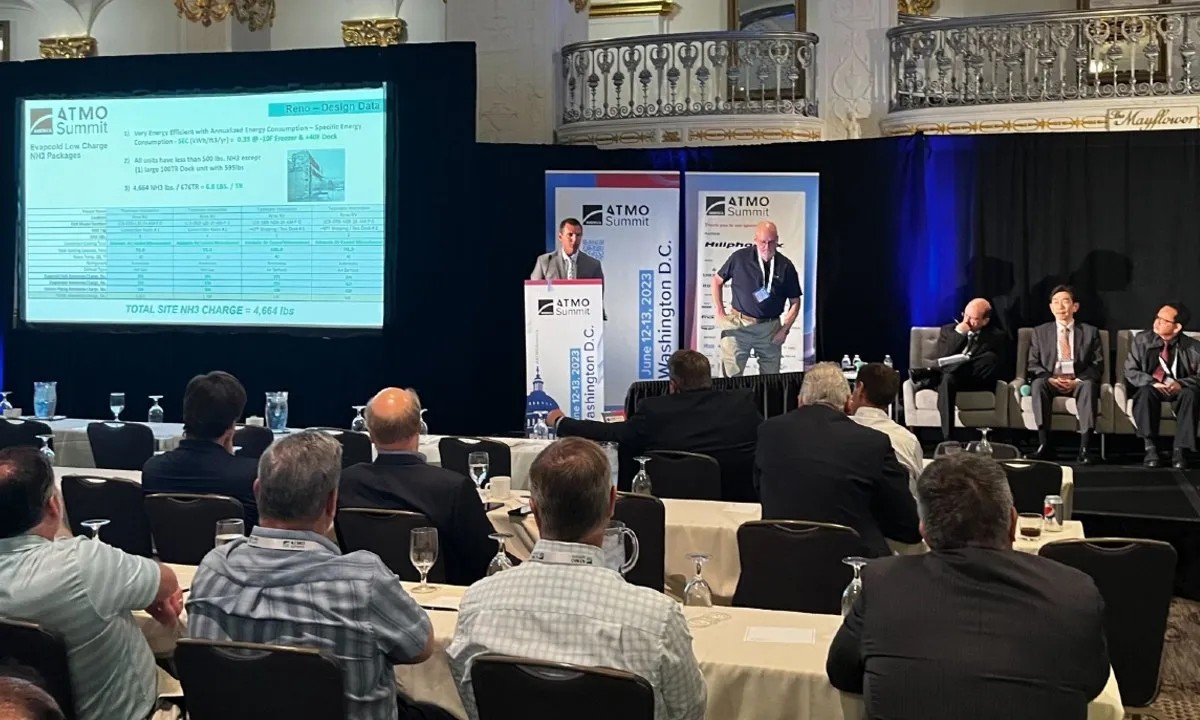Evapco installs its first low-charge ammonia split systems in Nevada cold storage facility
July 03, 2023

U.S.-based OEM Evapco has installed its first low-charge ammonia (R717) split refrigeration systems at a cold storage facility in Reno, Nevada. The project was completed in partnership with specialist contractor Ti Cold, which views the technology as “revolutionary” for the industry.
The new Tahoe-Reno Industrial Center’s five cold rooms and loading dock are cooled by 10 Evapcold LCR-S Split Systems, which provide a total of 676TR (2.4MW) of cooling capacity with just 4,664lbs (2,116kg) of ammonia.
Each system consists of a rooftop adiabatic air-cooled condensing unit and two ceiling-mounted evaporators. Previously released Evapcold units include an evaporator.
Details of the project were presented by Mark Shaffer, Design Manager at Evapco, and Jerry Tippmann, Director of Refrigeration at Ti Cold, during a Refrigeration Case Study session at the ATMOsphere (ATMO) America Summit 2023 on natural refrigerants. The conference took place June 12–13 in Washington, D.C., and was organized by ATMOsphere, publisher of Ammonia21.com.
At the time of the presentation, the Reno project had not yet been commissioned due to a delay in the supply of the facility’s main electrical gear, explained Tippmann.
‘State-of-the-art’ facility
The facility houses 255,000ft2 (23,690m2) of cold storage across five rooms. Each room can be converted between 35°F (1.7°C) for medium temperature and -10°F (-23°C) for low temperature. Roughly 436TR (1.5MW) in cooling capacity is required for the center’s cold storage rooms.
The three smaller cold rooms (around 33,200ft2/3,084m2 each) are served by their own 72TR (253kW) dual compressor units to allow for redundancy (with the extra compressor), while the two larger storage rooms (around 49,500ft2/4,599m2 each) are cooled via a total of four 55TR (193kW) single compressor units.
The 40,000ft2 (3,716m2) of loading dock space is cooled to 40°F (4.4°C). The space receives 240TR (844kW) in cooling capacity from one 100TR (352kW) dual compressor unit and two 70.2TR (247kW) single compressor units.
To ensure optimum energy efficiency during Nevada’s hot summer months, the Evapcold systems include adiabatic air-cooled condensing for when temperatures rise above 80°F (26.7°C). In total, the adiabatic coolers consume around 4 million gallons (15.1 million liters) of water a year, which is around 74% less water than a traditional refrigeration plant, according to Shaffer.
“In Reno, they have very strict water regulations, and water allotment is deeded to the property, so the adiabatic fell right in the allotment,” added Tippmann.
Cheaper and more efficient option
Nine out of the facility’s 10 systems have less than 500lbs (227kg) of ammonia in them, including the condensing unit, evaporators and field piping, explained Shaffer. The larger 100TR system contains 595lbs (270kg) of R717.
Overall, the systems use around 6.8lbs of ammonia for every TR of cooling capacity (889g/kW).
Analysis conducted by Evapco and Ti Cold, which looked at estimated electric, water and sewage usage, indicates that Evapco’s low-charge ammonia systems will cost the cold storage facility roughly $686 (€624) per TR per year ($166/€151 per kW per year). According to Shaffer, this is around one-third the cost of a stick built central system.
The system is “very energy efficient,” Shaffer said, with a specific energy consumption (SEC) of 0.39kWh per ft3 per year (13.8kWh per m3 per year). The SEC of a stick-built system is about three times higher than Evapco’s low-charge ammonia systems, he added. (Scantec Refrigeration Technologies in Australia has reported an SEC of 20–24 kWh per m3 per year/0.57–0.68 kWh per ft3 per year for its centralized low-charge ammonia DX system.)
To further improve energy and cost efficiency, Evapco’s SelectTech supervisory control system oversees the 10 Evapcold systems, as well as the building’s ammonia and refrigeration safety controls.
“If cold rooms aren’t being used, their units can be shut off and monitored for energy management and historical trending,” explained Shaffer. “In turn, this can save a significant amount of money.”
Evapco’s ‘Mega Split’
Building on its existing LCR-S Split System, Evapco is working to develop a larger system that the manufacturer will launch later this year.
The “Mega Split” will double the cooling capacity of the condensing unit and serve up to six evaporators, Shaffer said. The ceiling-mounted evaporators can be installed in different rooms and provide different temperatures.
The larger system will be able to provide up to 130TR (457kW) for low temperature and up to 150TR (528kW) for medium temperature.
Depending on the size and number of evaporators in the system, each Mega Split will require 650–700lbs (295–318kg) of ammonia.
Due to the fact that the Mega Split’s condensing unit can either be installed on a building’s roof or on the ground, it is well suited for both new construction and retrofits, particularly HFC replacement projects, he added.
Evapco and Ti Cold have worked together on low-charge ammonia projects for a few years, including cold storage facilities in Sioux Falls, South Dakota, and Ontario, Canada.


